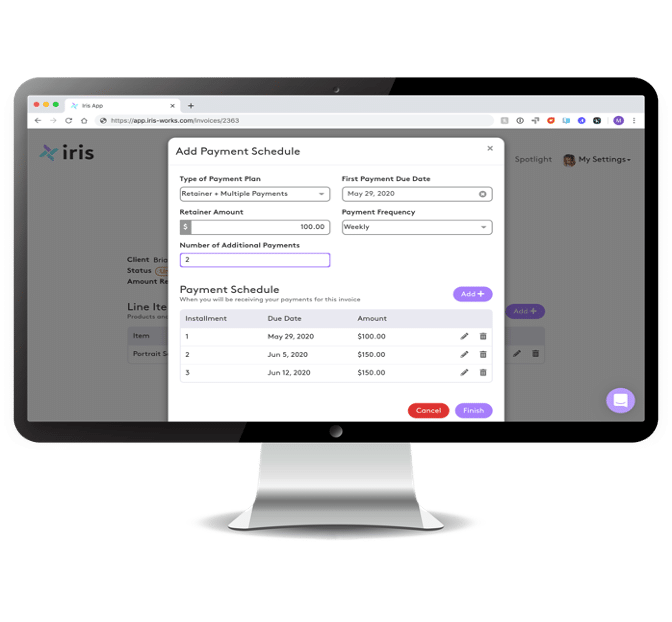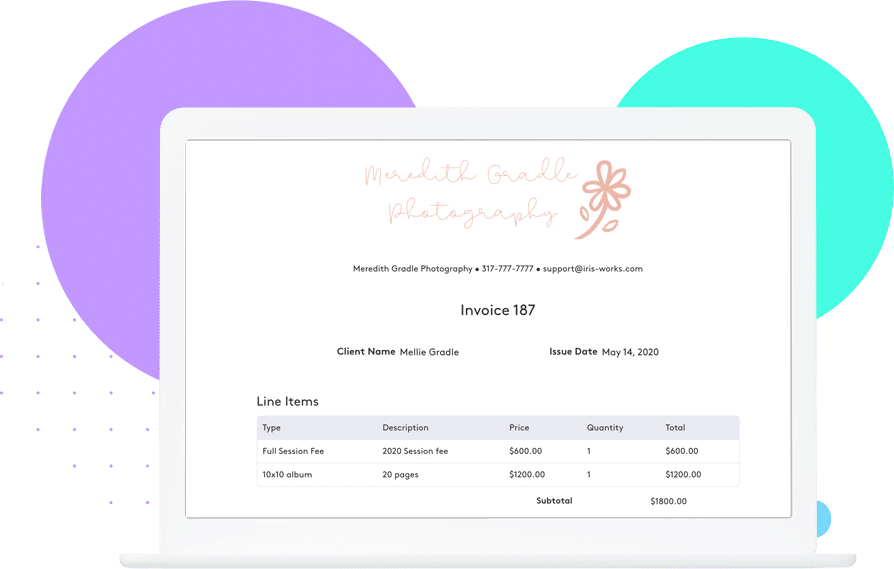
Understanding Photography Invoicing
When it comes to photography invoicing, understanding your clients’ needs is crucial. Not only does this help you ensure that your services are being provided efficiently and effectively but also helps in generating invoices that accurately reflect the work done. One way to streamline the process of creating invoices is by using templates. Templates can be customized according to different types of services offered and specific client’s needs.
It’s important for a photography invoice to have all necessary information included such as date, service details, pricing breakdowns, payment terms and contact information. Invoicing mistakes can easily happen if not careful so it’s essential always double-checking each invoice before sending them out. By avoiding these common errors in photography invoicing, you will save time and money while ensuring accurate billing for your clients.
Why Photography Invoicing is Important
As a professional photographer, invoicing is an essential aspect of running your business. It ensures timely payment for your services and helps you track income and expenses for tax purposes. Without clear invoices outlining the scope of work and fees, clients may delay or forget to pay, causing financial strain on your business.
Clear and detailed photography invoicing establishes a professional image with clients, ensures timely payment, and helps track income and expenses for tax purposes.
Moreover, photography invoicing establishes a professional image with clients by presenting detailed records of the work performed. Utilizing pre-made templates for invoices streamlines the process and allows you to focus on creating stunning images rather than time-consuming administrative tasks. By prioritizing proper invoicing techniques in your business practices, you can increase efficiency while maintaining a high level of professionalism towards clients.
Common Mistakes to Avoid in Photography Invoicing
Photography invoicing is crucial for maintaining a healthy cash flow and building strong business relationships with clients. However, there are several common mistakes that photographers make when creating invoices. One of the biggest mistakes is not including detailed descriptions of services provided, which can lead to confusion or disputes with clients over charges. To avoid this mistake, it’s important to clearly outline what services were provided and any additional costs associated with those services.
Another mistake to avoid in photography invoicing is sending invoices too late or inconsistently. This can create frustration for both the photographer and their clients, as delays in payment can disrupt financial planning and strain professional relationships. It’s best practice to establish a regular schedule for invoice creation and delivery using templates that include all necessary information.
Forgetting to include payment terms and due dates on invoices is another common error made by photographers when invoicing their clients. This omission can cause confusion about when payment is expected, leading to delays or missed payments altogether. Including clear payment terms such as due dates, accepted forms of payment, and penalties for late payments will help prevent these issues from occurring.
In conclusion, avoiding these common mistakes in photography invoicing will improve billing accuracy while fostering better communication between photographers and their clients regarding prices expectations so they know exactly what they’re paying for upfront without any surprises down the road!
Important Elements of a Photography Invoice
Client information, detailed descriptions of services provided, and payment terms are essential elements of a photography invoice. A well-crafted invoice can establish credibility and streamline the payment process, ensuring you get paid on time for your work. Here’s what to include in your photography invoices:
- Client Information: Name, Address, Contact Details
- Detailed Description of Services Provided: List out all the specific services or products you provided.
- Pricing Breakdowns: Include prices for each service/product separately so that clients know exactly what they’re paying for.
- Payment Terms: Specify due date and accepted forms of payment (e.g., check or online transfer).
By following these tips and best practices in creating an effective photography invoice template, you’ll not only maintain professionalism but also ensure that both parties have a clear understanding of the agreed-upon terms.
Best Practices in Photography Invoicing
When it comes to photography invoicing, there are a few best practices that every photographer should follow to ensure timely payment and a professional reputation. First, clearly establish your payment terms upfront with clients and include them in your contract or agreement. This includes specifying the deposit amount, the due date for final payment, and any late fees or penalties.
Secondly, create a professional invoice template that includes all necessary information such as the client’s name and contact information, services provided with detailed descriptions if necessary, rates charged per hour, or project fee if applicable. Also include taxes applied if any as well as total due amount including any discounts applied. Make sure to keep track of all invoices sent out using an a system like Iris Works!
Establishing Your Payment Terms
When establishing payment terms for your photography business, it’s important to consider three key factors: payment deadlines, acceptable payment methods, and penalties for late payments. Deciding on a suitable deadline is crucial as it ensures you’ll receive payment within a reasonable timeframe. Consider the scope of the project and any external factors that may affect your client’s ability to pay.
Additionally, providing multiple acceptable payment methods makes paying easier for clients. Offer options such as bank transfers or credit cards so that they can choose what works best for them. Square + Iris gives you the ability to offer multiple payment options to your clients. Lastly, including penalties in your invoice is an effective way to incentivize timely payments while also protecting yourself from delayed compensation. Be sure to communicate these terms clearly with clients before beginning work on any project.

Setting Your Photography Rates
Researching industry standards is crucial when setting your photography rates. Look at what other photographers in your area are charging for similar services and adjust accordingly based on factors such as experience, equipment quality, and niche specialization.
Calculating your costs and expenses is also important to ensure you’re not undercharging or overpricing yourself. Consider all the expenses that go into each photoshoot, including but not limited to: travel costs, rentals, editing software fees, insurance fees etc.
At the same time it’s important to consider the value of your services – what sets you apart from others in the market? Your unique skillset or creative vision can justify higher rates than someone who shoots standard portraits with no special techniques or styles. Keep these points in mind when deciding on an appropriate pricing strategy for your photography business.
Creating a Professional Invoice Template

Including all necessary information, designing an aesthetically pleasing format, and making sure it complies with legal requirements are the key elements in creating a professional invoice template for your photography business.
When including necessary information on your invoice, make sure to include your contact details and those of the client as well as a detailed description of the project. Designing an aesthetically pleasing format can be achieved by using color schemes and typography that aligns with your brand’s identity. Additionally, ensuring compliance with tax regulations is essential when creating invoices.
To summarize:
- Include all relevant contact details
- Provide a detailed project description
- Use colors and typography in line with branding
- Ensure compliance with tax regulations
Following Up on Overdue Invoices
When it comes to invoicing for your photography services, following up on overdue payments is an essential part of ensuring timely and consistent cash flow. Here are some tips to help you follow up effectively:
- Send a friendly reminder email or letter as soon as the payment becomes overdue.
- Be clear about late fees and consequences in your contract before starting work with a client.
- Maintain professionalism and keep communication lines open even when dealing with difficult clients.
In addition, consider implementing an automated system that sends reminders at specific intervals, such as 7 days past due date or 14 days past due date. By staying on top of unpaid invoices, you can improve your financial management and protect the profitability of your photography business. By using Iris Works workflows, you will never miss another payment.
One of the best tips for effective photography invoicing is to clearly communicate with your clients. Make sure your invoice includes all the necessary details, such as project description, date and time of services rendered, and any additional fees or expenses. It’s also a good idea to set clear payment terms upfront, including due dates and accepted forms of payment.
Another important aspect of photography invoicing is tracking your invoices and payments. Keep an organized record of which invoices have been sent out, when they are due, and whether they have been paid or not. This will help you stay on top of overdue payments and avoid any potential cash flow issues down the line.
Communicating Clearly with Clients
Setting clear payment terms and due dates is crucial to maintaining a professional relationship with your photography clients. By providing these details upfront, you can avoid any confusion or misunderstandings later on. Additionally, it’s important to provide detailed descriptions of the services rendered so that clients understand exactly what they are paying for.
Being transparent about any additional fees or charges is also key in communicating clearly with your photography clients. No one likes surprises when it comes to billing, so make sure that all costs are outlined in detail before work begins. This helps build trust between you and your client and ensures that everyone is on the same page throughout the invoicing process.
Tracking Your Invoices and Payments
Organizing your invoices and receipts is crucial for efficient photography invoicing. Create a system that works for you, whether it’s through digital or physical filing. This will make it easier to track payments and ensure nothing falls through the cracks.
Sending reminders for upcoming payments or past-due amounts can help prevent late payments and keep your cash flow steady. Use software or apps that automate this process so you don’t have to spend valuable time manually sending reminders.
It’s important to regularly reconcile your records to ensure accuracy in your accounting. This involves comparing your invoices, receipts, and bank statements to identify any discrepancies or errors that need correcting. By doing this consistently, you’ll avoid costly mistakes down the line and maintain a clear overview of your financials.
Invoicing for Additional Services or Expenses
Clearly outlining the scope of work in your initial contract is crucial when it comes to invoicing for additional services or expenses. It helps to avoid misunderstandings and ensures that both parties are on the same page throughout the project. Providing a detailed breakdown of expenses incurred during the project is also important, as clients want transparency and accountability. Agreeing on payment terms before rendering any additional services beyond what was initially agreed upon can prevent confusion down the line.
Here are some tips for photography invoicing when it comes to charging for additional services or expenses:
- Clearly state in your contract what constitutes an “additional service”
- Document all relevant costs and provide receipts or invoices
- Negotiate payment terms upfront, including timelines and late fees if applicable
By following these best practices, you can streamline your invoicing process while ensuring that payments are made fairly and transparently. Need help understanding contracts? Check out this blog.
Dealing with Late Payments
Having a clear policy in place for late fees is crucial when dealing with photography invoicing. Clearly communicate this policy to clients from the beginning, so there are no surprises if they miss a payment. Following up promptly with clients who have missed payments is also essential. Don’t hesitate to send reminders or follow-up emails as soon as an invoice becomes overdue.
It’s important to cultivate good relationships with your clients while still being firm about invoice deadlines. Make sure you’re maintaining open lines of communication and addressing any concerns they may have about their invoices or payments. This will help establish trust and make it easier to address late payments should they occur in the future.
Conclusion
In conclusion, a well-crafted photography invoice is essential for any professional photographer. The invoicing process should be streamlined and efficient to avoid delays in receiving payments from clients. Remember to include all necessary details such as the client’s information, services rendered, and total costs in your invoices.
Furthermore, it is crucial to maintain good communication with your clients throughout the invoicing process. This will help you avoid any misunderstandings or disputes over payment later on. By implementing these tips and best practices into your photography invoicing procedures, you can ensure that you get paid on time while maintaining excellent customer relationships.
Tips for Effective Photography Invoicing
As a professional photographer, invoicing might not be your favorite part of the job, but it is essential to keep your business running smoothly. In this ultimate guide to photography invoicing, we will cover everything you need to know about creating effective and efficient invoices that help you get paid on time and maintain great relationships with clients. From understanding photography invoicing basics and best practices to tips for making the process easier, this guide has got you covered. Let’s dive in!
Recent posts


